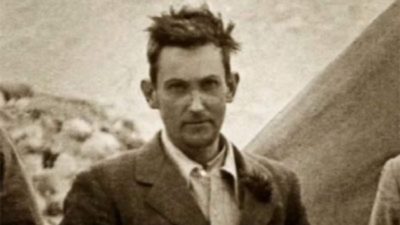The grand prize of mountaineering is Everest, for obvious reasons. It’s not the most difficult or dangerous mountain, but it invites the adventurous to stand at the peak of the world. It’s the spot closest the sun, moon and stars, the ultimate junction of earth and sky, with the ultimate panoramic horizon.
It allows the brave to revel above the clouds, look upwards into the void and leave the earth behind. Mount Everest was first recorded in the Atlas of the Whole Imperial Territory as Qomolangma, its traditional Tibetan name, in 1719. It was discovered to be the world’s tallest mountain in 1856 and named after George Everest, head of the Great Trigonometrical Survey of India.
It was in 1924 that George Mallory and Andrew Irvine got near – or perhaps reached – the summit on a third attempt, but never make it back down. It wasn’t until 1953 when Sherpa Tenzing Norgay and New Zealand climber Edmund Hillary reached the summit to claim the prize of first to conquer the peak.
My fascination with the mountain and the story of Mallory began as a teenager when I came across an epic story of mountaineering: The Fight for Everest, the account of George Mallory and Andrew Irvine’s 1924 expedition, when they disappeared neat the summit, giving rise to folklore as to whether they had reached the top of the world.
I started to collect books about exploration, adventure and mountaineering – and my affinity with Amundsen, Scott, Mawson, Nansen, Hilary, Herzog, Compagnoni and Lacedelli, Shackleton and Mallory began.
I started to read The Fight for Everest. Its black-and-white photographs and its fold-out maps captured my imagination. I was carried to the Himalayas. The images rushed over me, I could see the distant white peaks, snowstorms approaching and the climbers reaching up the ice-walls on the North Col, scaling with ropes, the sheer brutal physicality of effort coming to life.
I have still marked the passage of the book that etched an enduring memory, the description by Noel Odell, the expedition geologist, of his last sighting of Mallory and Irvine, some 800 vertical feet from the summit on June 9, 1924:
There was a sudden clearing of the atmosphere above me, and I saw the whole summit ridge and final peak of Everest unveiled. I noticed far away on a snow slope leading up to what seemed to me to be the last step but one from the base of the final pyramid, a tiny object moving and approaching the rock step. A second object followed, and then the first climbed to the top of the step. As I stood intently watching this dramatic appearance, the scene became enveloped in cloud…
Over and over I’ve read that passage, and I wanted nothing more than to be one of those two tiny dots, fighting for survival in the thin, icy air, unfazed by adversity. That was it. I lived intensely with and through these explorers, spending evenings with them in their tents, thawing pemmican hoosh.
No evidence, apart from this testimony, has been found that they climbed higher than the First Step (one of three final physical stages to the summit) as their spent oxygen cylinders were found shortly below the First Step, and Irvine’s ice axe was found nearby in 1933. They never returned to their camp and died high on Everest.
On 1 May 1999, a US climber, Conrad Anker, found a frozen body at 26,760 ft. on the north face of the mountain. The body was intact. Name tags on the body’s clothing bore the name of G. Leigh Mallory. No subsequent searches have found either Irvine’s body or a Kodak camera, known to be in their possession, which could hold the answer as to whether they were on the top of the world 30 years before Hilary.
Mallory carried a photograph of his wife, Ruth, which he was going to leave at the summit. When his body was discovered, the photograph was missing. I like to think it was left at the summit. Whether it will ever be proven that he reached the top or not, he had climbed to an altitude of at least 28,000 feet in 1924 with clothing and equipment far inferior to what is available today, a remarkable feat.
Mallory took part in the first three British expeditions to Everest in the early 1920s, joining the 1924 Everest expedition believing that at 37, it would be his third and last opportunity to climb the mountain. Mallory’s grandson, also named George, reached the summit of Everest in 1995. He left a picture of his grandparents at the summit citing unfinished business.
For Mallory, this was not recreation or physical challenge, that was not what he sought – he pursued the pure adventure of climbing. It was Mallory with the famous aphorism that, to this day, best summarises the avid climber’s pursuit, quoted as having replied to the question Why do you want to climb Mount Everest? with the retort Because it’s there. These have often been called ‘the most famous three words in mountaineering’.
I’ve kept Mallory’s retort in my head for many years, as did President Kennedy, who quoted Mallory in his speech announcing the NASA programme in 1962, and his own words with the same sentiment of ambition: We choose to go to the moon in this decade and do the other things, not because they are easy, but because they are hard, because that goal will serve to organize and measure the best of our energies and skills, because that challenge is one that we are willing to accept, one we are unwilling to postpone, and one which we intend to win, and the others, too.
As Mallory said in one of his final interviews, when trying to explain why he was climbing Everest, I have dreamt since I was a boy of standing atop this mountain, and it’s worth it to risk your life to make a dream come true. It turns out that Mallory answered his own question more fully, and perhaps even more beautifully, a year prior to his famous quip:
The first question which you will ask and which I must try to answer is this, ‘What is the use of climbing Mount Everest?’ and my answer must at once be, ‘It is no use’…. if you cannot understand that there is something in man which responds to the challenge of this mountain and goes out to meet it, that the struggle is the struggle of life itself upward and forever upward, then you won’t see why we go.
What we get from this adventure is just sheer joy. And joy is, after all, the end of life. We do not live to eat and make money. I look back on tremendous efforts, exhaustion and looking out of a tent door on to a dismal world of snow and vanishing hopes.
Mallory is one of our last great explorers and a truly ambitious man. Remember this was the 1920s, Mallory had to hike through miles of unchartered Nepalese jungle without a map. He hadn’t even seen Everest until he arrived there, and yet from the second he heard the idea he never hesitated. He is so revered that the ice-wall on the North Col which must be climbed for all who summit Everest via the North Route is named after him: the Mallory Step.
While today climbing Everest is almost commonplace, back then it was possibly the most daunting physical challenge available. The highest peak that had been ascended was Montblanc, at 15,000 feet, which Mallory had climbed.
Mallory epitomises unwavering entrepreneurial ambition and the attitude to succeed. He had focus and clarity on his goals, and a tenacious will-to-win, qualities needed to be an entrepreneur. Starting and running a business is a lot like climbing a mountain for the first time, look at the similarities:
- Searing ambition Entrepreneurs are driven to succeed and grow. They see the bigger picture, set massive goals and stay committed to achieving them regardless of challenges that arise. Mallory had this in abundance.
- Strong self-belief Entrepreneurs often have a strong and assertive personality, focused and determined to achieve their goals and believe completely in their ability to achieve them. Mallory has the same inner confidence.
- To be a pioneer Mallory had a passionate desire to be the first man on Everest, just as entrepreneurs look to bring new ideas to market. They are pioneers too, in their aspirations and approach to the task and opportunity before them.
- Competitive by nature Successful entrepreneurs thrive on competition. The only way to reach their goals and live up to their self-imposed high standards is to be the best they can be. Mallory’s wasn’t competitive with other climbers – but with himself and the mountain before him.
- Highly motivated and energised Mallory was always on the go, full of energy and highly motivated. Entrepreneurs have a similar high work ethic, restless and always trying to get to where they want to get.
- Accepting of obstacles Entrepreneurs are on the front line and hear the words it’s never been done, it can’t be done as opportunity. They readjust their path, obstacles are an expected part of the journey. Everest was both a physical and mental obstacle in Mallory’s journey.
Sometimes if you haven’t got your head up from the startup grind for a while, your vision can get cloudy. Mallory’s story and attitude reminds me that there’s a purpose and a reason for your dedication and hard work: Do stuff because it matters, for the purpose of a creating a story to tell that what you’ve done matters, and that it made a difference. It’s because the challenge exists; because it’s there.
Don’t get lost in startup life’s busy shuffle and the noise. Remember those three words: Because It’s there, the three words that drove George Mallory, possibly the first man to reach the summit of Everest. Mallory reminds me not just to ‘do things’, but to do them with a passion and a purpose bigger than ‘just turning up’. Make it count, where it matters, for yourself.
Mallory was obsessed with conquering Everest. He knew that after two previous attempts the expedition in 1924 would be his last chance. I don’t believe he of all people would have turned around above the Second Step, especially if he was still moving, as Odell described, with considerable alacrity. Once above the Third Step, it seems unthinkable they didn’t make the summit.
Mallory is still on Mount Everest, and he got higher than anybody else before him. The question has always been whether he was going up or coming down – the position of the body suggests that Mallory was climbing down the mountain, rather than up it. I believe George Mallory and Sandy Irvine did reach the summit of Everest in 1924. Whether he got to the top is not the most important thing for me. Mallory’s story is what is remarkable.
Startup life isn’t as risky to life and limb, but there is no summit or finishing line, the climb just carries on. Make a start, keep reaching out and pushing yourself, and ask yourself why do I want this? – and you have the answer from Mallory: Because it’s there.



